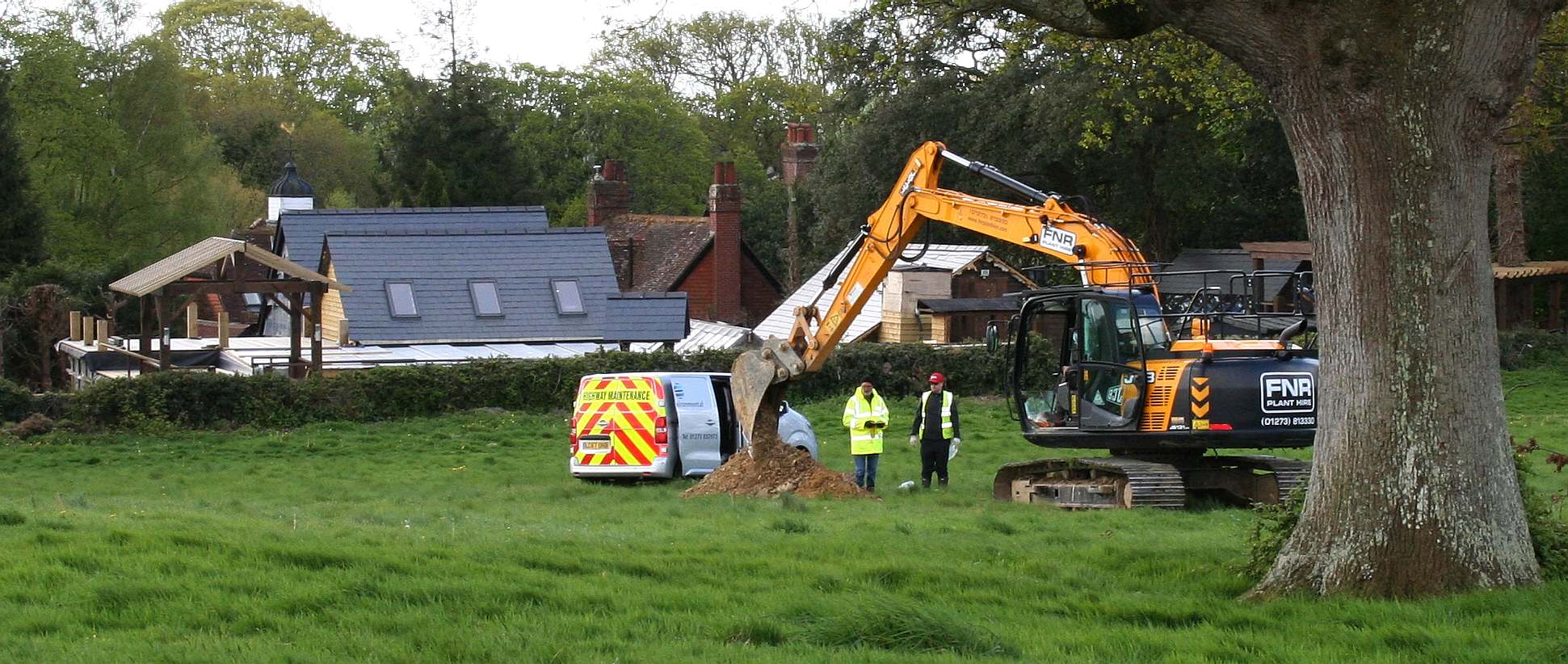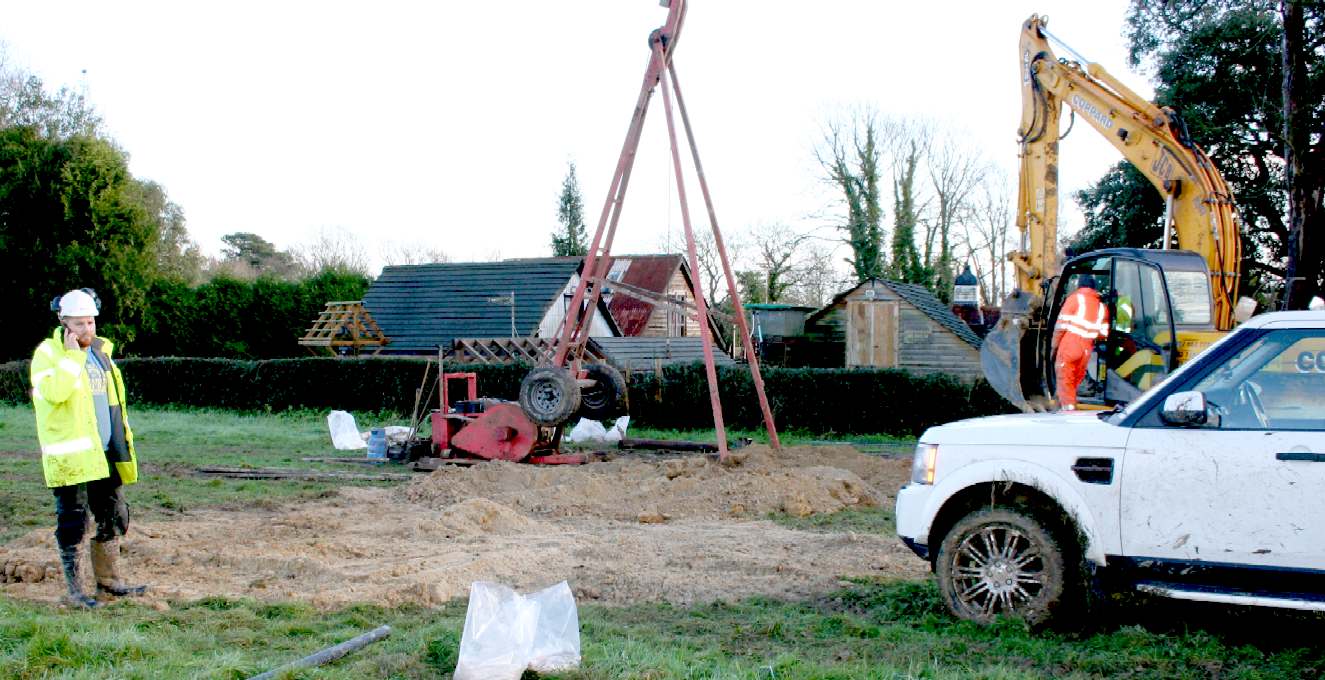|

WATER
RIGHTS - Clarion Housing Group and Thakeham
Homes are in danger of spoiling an ancient well that supplies water
to many concerns in this vicinity. In the picture you can see a hired
digger scooping out trenches to test drainage by pouring in water and
measuring the rate of absorption by the soil. It seems to us that if you
build houses on the ground that feeds the ancient well, that
contamination from garden treatments such as Roundup and engine oils,
etc., will find its way into this well leading to claims against the
owners of the houses who would have been sold a pup, and/or against the
Council for approving the proposal, by way of a negligence claim, and/or
against the vendors or developers. Any way you look at it the developers
and Council concerned should take steps to ensure that no development
takes place until the proper tests and evaluations have been completed,
and after that stage, to ensure that any houses built in this location
will not be on a path that includes the water
table that feeds the ancient well.
Any
failure to conduct the proper tests and house situation, along with safe
sewage disposal, may tempt the Secretary
of State to call in the application. We imagine that all of those
with a financial interest in this piece of greenbelt will want to
resolve issues before it starts to get complicated.
ACHIEVING
SUSTAINABLE DEVELOPMENT
International and national bodies have set out broad principles of sustainable
development. Resolution 42/187 of the United Nations General Assembly
defined sustainable development as meeting the needs of the present without
compromising the ability of future generations to meet their own needs. The
UK Sustainable Development Strategy Securing the Future set out five ‘guiding
principles’ of sustainable development: living within the planet’s environmental
limits; ensuring a strong, healthy and just society; achieving a sustainable
economy; promoting good governance; and using sound science responsibly.
6. The purpose of the planning system is to contribute to the achievement of
sustainable development. The policies in paragraphs 18 to 219, taken as a
whole, constitute the Government’s view of what sustainable development in
England means in practice for the planning system.
7. There are three dimensions to sustainable development: economic, social and
environmental. These dimensions give rise to the need for the planning system to perform a number of roles:
●● an economic role – contributing to building a strong, responsive and
competitive economy, by ensuring that sufficient land of the right type is
available in the right places and at the right time to support growth and
innovation; and by identifying and coordinating development requirements, including the provision of infrastructure;
●● a social role – supporting strong, vibrant and healthy communities, by
providing the supply of housing required to meet the needs of present and
future generations; and by creating a high quality built environment, with
accessible local services that reflect the community’s needs and support its
health, social and cultural well-being; and
●● an environmental role – contributing to protecting and enhancing our
natural, built and historic environment; and, as part of this, helping to
improve biodiversity, use natural resources prudently, minimise waste and
pollution, and mitigate and adapt to climate change including moving to a low carbon economy.
8. These roles should not be undertaken in isolation, because they are mutually
dependent. Economic growth can secure higher social and environmental standards, and well-designed buildings and places can improve the lives of
people and communities. Therefore, to achieve sustainable development, economic, social and environmental gains should be sought jointly and
simultaneously through the planning system. The planning system should play an active role in guiding development to sustainable solutions.
9. Pursuing sustainable development involves seeking positive improvements in
the quality of the built, natural and historic environment, as well as in
people’s quality of life, including (but not limited to):
●● making it easier for jobs to be created in cities, towns and villages;
●● moving from a net loss of bio-diversity to achieving net gains for nature;
●● replacing poor design with better design;
●● improving the conditions in which people live, work, travel and take
leisure; and
●● widening the choice of high quality homes.
10. Plans and decisions need to take local circumstances into account, so that
they respond to the different opportunities for achieving sustainable development in different areas.
The presumption in favour of sustainable development
11. Planning law requires that applications for planning permission must be
determined in accordance with the development plan unless material considerations indicate otherwise.
12. This National Planning Policy Framework does not change the statutory status
of the development plan as the starting point for decision making. Proposed
development that accords with an up-to-date Local Plan should be approved,
and proposed development that conflicts should be refused unless other material considerations indicate otherwise. It is highly desirable that local
planning authorities should have an up-to-date plan in place.
13. The National Planning Policy Framework constitutes guidance for local
planning authorities and decision-takers both in drawing up plans and as
a material consideration in determining applications.
National Planning Policy Framework
14. At the heart of the National Planning Policy Framework is a presumption in
favour of sustainable development, which should be seen as a golden thread running through both plan-making and decision-taking.
For plan-making this means that:
●● local planning authorities should positively seek opportunities to meet the
development needs of their area;
●● Local Plans should meet objectively assessed needs, with sufficient
flexibility to adapt to rapid change, unless:
–– any adverse impacts of doing so would significantly and demonstrably
outweigh the benefits, when assessed against the policies in this Framework taken as a whole; or
–– specific policies in this Framework indicate development should be
restricted.9
For decision-taking this means:
●● approving development proposals that accord with the development plan
without delay; and
●● where the development plan is absent, silent or relevant policies are
out-of-date, granting permission unless:
–– any adverse impacts of doing so would significantly and demonstrably
outweigh the benefits, when assessed against the policies in this Framework taken as a whole; or
–– specific policies in this Framework indicate development should be
restricted.
15. Policies in Local Plans should follow the approach of the presumption in
favour of sustainable development so that it is clear that development which
is sustainable can be approved without delay. All plans should be based upon
and reflect the presumption in favour of sustainable development, with clear
policies that will guide how the presumption should be applied locally.
16. The application of the presumption will have implications for how communities engage in neighbourhood planning. Critically, it will mean that
neighbourhoods should:
●● develop plans that support the strategic development needs set out in
Local Plans, including policies for housing and economic development;
Achieving sustainable development
●● plan positively to support local development, shaping and directing
development in their area that is outside the strategic elements of the Local Plan; and
●● identify opportunities to use Neighbourhood Development Orders to
enable developments that are consistent with their neighbourhood plan to proceed.
Core planning principles
17. Within the overarching roles that the planning system ought to play, a set of
core land-use planning principles should underpin both plan-making and decision-taking. These 12 principles are that planning should:
●● be genuinely plan-led, empowering local people to shape their surroundings, with succinct local and neighbourhood plans setting out a
positive vision for the future of the area. Plans should be kept
up-to-date, and be based on joint working and co-operation to address larger than
local issues. They should provide a practical framework within which decisions on planning applications can be made with a high degree of
predictability and efficiency;
●● not simply be about scrutiny, but instead be a creative exercise in finding
ways to enhance and improve the places in which people live their lives;
●● proactively drive and support sustainable economic development to deliver
the homes, business and industrial units, infrastructure and thriving local
places that the country needs. Every effort should be made objectively to
identify and then meet the housing, business and other development
needs of an area, and respond positively to wider opportunities for growth. Plans should take account of market signals, such as land prices
and housing affordability, and set out a clear strategy for allocating sufficient land which is suitable for development in their area, taking
account of the needs of the residential and business communities;
●● always seek to secure high quality design and a good standard of amenity
for all existing and future occupants of land and buildings;
●● take account of the different roles and character of different areas,
promoting the vitality of our main urban areas, protecting the Green Belts
around them, recognising the intrinsic character and beauty of the countryside and supporting thriving rural communities within it;
●● support the transition to a low carbon future in a changing climate, taking
full account of flood risk and coastal change, and encourage the reuse of
existing resources, including conversion of existing buildings, and encourage the use of renewable resources (for example, by the
development of renewable energy);
National Planning Policy Framework
●● contribute to conserving and enhancing the natural environment and
reducing pollution. Allocations of land for development should prefer land
of lesser environmental value, where consistent with other policies in this
Framework;
●● encourage the effective use of land by reusing land that has been
previously developed (brownfield land), provided that it is not of high environmental value;
●● promote mixed use developments, and encourage multiple benefits from
the use of land in urban and rural areas, recognising that some open land
can perform many functions (such as for wildlife, recreation, flood risk
mitigation, carbon storage, or food production);
●● conserve heritage assets in a manner appropriate to their significance, so
that they can be enjoyed for their contribution to the quality of life of this
and future generations;
●● actively manage patterns of growth to make the fullest possible use of
public transport, walking and cycling, and focus significant development
in locations which are or can be made sustainable; and
●● take account of and support local strategies to improve health, social and
cultural wellbeing for all, and deliver sufficient community and cultural
facilities and services to meet local needs.
CONTACTS
Department for Communities and Local Government
Eland House
Bressenden Place
London,
SW1E 5DU
United
Kingdom
Telephone: 030 3444 0000

HINKLEY,
CALIFORNIA - GROUND WATER CONTAMINATION - The
town of Hinkley, California,
located in the Mojave Desert, (about 121 miles driving distance
north-northeast of Los Angeles) had its groundwater contaminated with
hexavalent chromium starting in 1952, resulting in a legal case
against Pacific Gas & Electric (PG&E) and a multimillion-dollar
settlement in 1996. The legal case was dramatized in the film Erin
Brockovich, released in 2000.
Residents of Hinkley filed a class action against PG&E,
encaptioned Anderson, et al. v. Pacific Gas and Electric (Superior Ct.
for County of San Bernardino, Barstow Division, file BCV 00300.
In 1993, Erin Brockovich, a legal clerk to lawyer Edward L. Masry,
investigated the apparent elevated cluster of illnesses in the
community linked to hexavalent chromium. The efforts of Brockovich and
Masry, and the plight of the people of Hinkley, became widely known
when the film Erin Brockovich was released in 2000.


After
many arguments, the case was referred to arbitration with maximum
damages of $400 million. After the arbitration for the first 40 people
resulted in roughly $110 million,
PG&E reassessed its position and decided to end arbitration and
settle the entire case. The case was settled in 1996 for $333 million,
the largest settlement ever paid in a direct-action lawsuit in U.S.
history.
In 2006, PG&E agreed to pay $295 million to settle cases involving
another 1,100 people statewide for hexavalent chromium-related claims.
In 2008, PG&E
settled the last of the cases involved with the Hinkley claims for $20
million.
LEAD
CASE: In the case of Wealden
District Council and planning application WD/2015/0090/MAO,
originally filed by Tim
Watson in 2014, then re-filed by Gleeson
Developments in 2015, and taken over by Clarion
Group and Thakeham
Group, there appear to be multiple errors in applying these
policies to greenbelt, including failing to protect open spaces and
the historic built environment, and not promoting sustainable
transport.
The
Horse
Sanctuary Trust are following this case with much interest. We
consider that the paper trail will eventually make interesting
reading, leading us to who is making the decisions and the money
........

GREENBELT
- Digging up Greenfield sites for quick
profits from windfall planning consents is ruining the heritage of
the nation. Once it is gone, it is gone. Britain is short of genuinely
affordable housing that developers are loath to provide where all they
want is the money. It may be that Clarion Housing and Thakeham intend
building affordable units on this site. They should also bear in mind
the requirement for sustainable development in United
Nations terms. Copyright photograph © April 26 2018, Herstmonceux
Museum Limited. All rights reserved. You may not copy this picture
except for educational
use.
|




